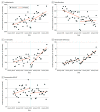Trends in Incident Prescriptions for Behavioral Health Medications in the US, 2018-2022
- PMID: 38198145
- PMCID: PMC10782382
- DOI: 10.1001/jamapsychiatry.2023.5045
Trends in Incident Prescriptions for Behavioral Health Medications in the US, 2018-2022
Abstract
Importance: The COVID-19 pandemic reportedly increased behavioral health needs and impacted treatment access.
Objective: To assess changes in incident prescriptions dispensed for medications commonly used to treat depression, anxiety, attention-deficit/hyperactivity disorder (ADHD), and opioid use disorder (OUD), before and during the COVID-19 pandemic.
Design, setting, and participants: This was a cross-sectional study using comprehensive, population-level, nationally projected data from IQVIA National Prescription Audit on incident prescriptions (prescriptions dispensed to patients with no prior dispensing from the same drug class in the previous 12 months) dispensed for antidepressants, benzodiazepines, Schedule II (C-II) stimulants, nonstimulant medications for ADHD, and buprenorphine-containing medication for OUD (MOUD), from US outpatient pharmacies. Data were analyzed from April 2018 to March 2022.
Exposure: Incident prescriptions by drug class (by prescriber specialty, patient age, and sex) and drug.
Main outcomes and measures: Interrupted time-series analysis to compare changes in trends in the monthly incident prescriptions dispensed by drug class and percentage changes in aggregate incident prescriptions dispensed between April 2018 and March 2022.
Results: Incident prescriptions dispensed for the 5 drug classes changed from 51 500 321 before the COVID-19 pandemic to 54 000 169 during the pandemic. The largest unadjusted percentage increase in incident prescriptions by prescriber specialty was among nurse practitioners across all drug classes ranging from 7% (from 1 811 376 to 1 944 852; benzodiazepines) to 78% (from 157 578 to 280 925; buprenorphine MOUD), whereas for patient age and sex, the largest increases were within C-II stimulants and nonstimulant ADHD drugs among patients aged 20 to 39 years (30% [from 1 887 017 to 2 455 706] and 81% [from 255 053 to 461 017], respectively) and female patients (25% [from 2 352 095 to 2 942 604] and 59% [from 395 678 to 630 678], respectively). Trends for C-II stimulants and nonstimulant ADHD drugs (slope change: 4007 prescriptions per month; 95% CI, 1592-6422 and 1120 prescriptions per month; 95% CI, 706-1533, respectively) significantly changed during the pandemic, exceeding prepandemic trends after an initial drop at the onset of the pandemic (level changes: -50 044 prescriptions; 95% CI, -80 202 to -19 886 and -12 876 prescriptions; 95% CI, -17 756 to -7996, respectively). Although buprenorphine MOUD dropped significantly (level change: -2915 prescriptions; 95% CI, -5513 to -318), trends did not significantly change for buprenorphine MOUD, antidepressants, or benzodiazepines.
Conclusions and relevance: Incident use of many behavioral health medications remained relatively stable during the COVID-19 pandemic in the US, whereas ADHD medications, notably C-II stimulants, sharply increased. Additional research is needed to differentiate increases due to unmet need vs overprescribing, highlighting the need for further ADHD guideline development to define treatment appropriateness.
Conflict of interest statement
Figures

Similar articles
-
Prescribing of Opioid Analgesics and Buprenorphine for Opioid Use Disorder During the COVID-19 Pandemic.JAMA Netw Open. 2021 Apr 1;4(4):e216147. doi: 10.1001/jamanetworkopen.2021.6147. JAMA Netw Open. 2021. PMID: 33856474 Free PMC article.
-
Comparing actual and forecasted numbers of unique patients dispensed select medications for opioid use disorder, opioid overdose reversal, and mental health, during the COVID-19 pandemic, United States, January 2019 to May 2020.Drug Alcohol Depend. 2021 Feb 1;219:108486. doi: 10.1016/j.drugalcdep.2020.108486. Epub 2021 Jan 6. Drug Alcohol Depend. 2021. PMID: 33421802 Free PMC article.
-
Psychotropic Medication Prescribing for Children and Adolescents After the Onset of the COVID-19 Pandemic.JAMA Netw Open. 2024 Apr 1;7(4):e247965. doi: 10.1001/jamanetworkopen.2024.7965. JAMA Netw Open. 2024. PMID: 38652474 Free PMC article.
-
Medicines associated with dependence or withdrawal: a mixed-methods public health review and national database study in England.Lancet Psychiatry. 2019 Nov;6(11):935-950. doi: 10.1016/S2215-0366(19)30331-1. Epub 2019 Oct 3. Lancet Psychiatry. 2019. PMID: 31588045 Free PMC article. Review.
-
Defining "Doctor Shopping" with Dispensing Data: A Scoping Review.Pain Med. 2022 Jul 1;23(7):1323-1332. doi: 10.1093/pm/pnab344. Pain Med. 2022. PMID: 34931686
Cited by
-
Fluctuations in dispensed out-patient psychotropic medication prescriptions during the COVID-19 pandemic in The Netherlands.BJPsych Open. 2025 Mar 20;11(2):e64. doi: 10.1192/bjo.2024.867. BJPsych Open. 2025. PMID: 40109012 Free PMC article.
-
Prescription Stimulant Use, Misuse, and Use Disorder Among US Adults Aged 18 to 64 Years.JAMA Psychiatry. 2025 Jun 1;82(6):572-581. doi: 10.1001/jamapsychiatry.2025.0054. JAMA Psychiatry. 2025. PMID: 40105821
-
Trends in hospital mortality of patients with status epilepticus in the ICU before and during the COVID-19 pandemic.Medicine (Baltimore). 2025 Apr 25;104(17):e42219. doi: 10.1097/MD.0000000000042219. Medicine (Baltimore). 2025. PMID: 40295292 Free PMC article.
-
Socioeconomic status and prescribing of ADHD medications: a study of ICB-level data in England.BMJ Ment Health. 2025 Mar 11;28(1):e301384. doi: 10.1136/bmjment-2024-301384. BMJ Ment Health. 2025. PMID: 40068887 Free PMC article.
-
Neural basis for individual differences in the attention-enhancing effects of methylphenidate.Proc Natl Acad Sci U S A. 2025 Apr;122(13):e2423785122. doi: 10.1073/pnas.2423785122. Epub 2025 Mar 24. Proc Natl Acad Sci U S A. 2025. PMID: 40127280 Free PMC article.
References
-
- Garnett MF, Curtin SC. Suicide mortality in the US, 2001-2021. NCHS Data Brief. 2023;(464):1-8. - PubMed
MeSH terms
Substances
LinkOut - more resources
Full Text Sources
Medical
Miscellaneous

